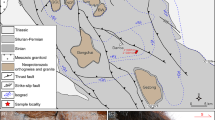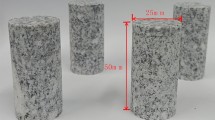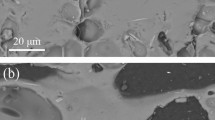Abstract
A backscattered and secondary electron SEM study of the grain boundary microstructure in quartz mylonites sampled along the length of the retrograde Simplon Fault Zone established three characteristic components. (1) Fine isolated pores (≤ 1 μm diameter) are scattered across two-grain interfaces, preferentially concentrated on surfaces in extension. Pores are uncommon on three-grain junctions and there is no evidence for fluid interconnectivity along three- and four-grain junctions. The fine porosity may develop by accumulation of original, mainly intragranular fluid inclusions to the grain boundary during deformation and recrystallization and by cavitation of grain boundaries during grain boundary sliding. Dynamic cavitation implies that the “ductile” mylonitic deformation is at least locally dilatant and therefore pressure sensitive. (2) Large “vug”-like pores (up to mm-scale) extend along multi-grain boundaries. Observed in all samples, they are most common in the higher initial temperature, coarse-grained samples with a microstructure dominated by grain boundary migration recrystallization. Grains bordering this connected porosity develop perfect crystal faces, undecorated by fine pores or pits. The irregular “lobate” optical microstructure of many migrating grain boundaries actually consists of a series of straight crystal faces. The coarse porosity is probably due to accumulation during dynamic recrystallization of (CO2-rich ?) fluid with a high wetting angle against quartz. (3) In one sample, interconnected sinuous ridges, ≤ 0.2 μm high, are observed to follow three- and four-grain junctions and disjoint into more isolated worms and spheroidal globules. On two-grain interfaces, these are transitional to more branching vein-like or convoluted brain-like forms. The brain-like and globular forms have been observed, with varying frequency, through the range of samples, with the globules attaining sizes of up to 60 μm. Vein structures have also been observed on intragranular fractures. These topologies do not match across adjoining surfaces and must have developed into free space. The ridge-vein-brain-spheroid structure is distinctly different to that previously observed on experimentally healed microcracks and its origin is not unequivocally established. They could represent unstable meniscus necking of a thin grain-boundary phase of low viscosity, developed due to quasi-adiabatic shear and/or local stress-induced dilatancy during microcracking.
Similar content being viewed by others
Author information
Authors and Affiliations
Additional information
Received: 11 April 1997 / Accepted: 7 November 1997
Rights and permissions
About this article
Cite this article
Mancktelow, N., Grujic, D. & Johnson, E. An SEM study of porosity and grain boundary microstructure in quartz mylonites, Simplon Fault Zone, Central Alps. Contrib Mineral Petrol 131, 71–85 (1998). https://doi.org/10.1007/s004100050379
Issue Date:
DOI: https://doi.org/10.1007/s004100050379




